

Sant' Antonio da Padova (13th century)
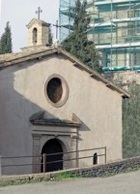
Pope Innocent X suppressed the Franciscan community in 1651. The church passed to the Oratorian Fathers of San Filippo Neri (below) two years later.
Chiesa del Crocifisso (1562)
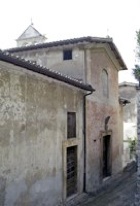
[I have not managed to visit the church, but it apparently has a fine Baroque interior.]
The decoration of the Cappella di Sant’ Agata in the church is attributed to Giovanni Antonio Scaramuccia.
Chiesa dell' Ospizio (1517)

The inscription on the door records:
MDXVII/ T(EM)P(O)RE P(RI)ORAT(I)/
BIA(N)CI JACOBI CELLI
(1517/ in the time of Prior/ Bianco Jacopo Celli)
San Fabiano (12th century)
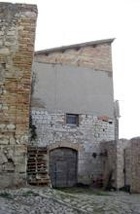
The community drew its priors from the most important families of Trevi until 1676, when Pope Clement X sent his own choice of Crispolto Paolelli. He found the church to be abandoned and derelict and he transferred its parish responsibilities to Santa Maria in Sion (below).
The complex was finally demolished in the early 20th century.
San Filippo Neri (1643)
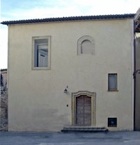
The community moved to Santa Maria in Sion (below) in 1676. The property was subsequently returned to domestic use.
Santa Maria della Piaggia (demolished)
This church was built in 1545 to replace the Oratorio della Confraternita di Santa Maria della Piaggia, which had been documented in 1358 and subsequently demolished. In 1818, it became the seat of the combined confraternities of Trevi, but it was subsequently abandoned. Material from the church was used in 1889-91 in the restoration of the campanile of the nearby church of Santa Lucia.
Art from the Church
Cornice of a Processional Standard (ca. 1478)
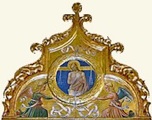
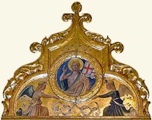
Sources in the 18th century document a gilded cornice with an image of the Crucified Christ above a panel of the Assumption of the Virgin on the altar of the church. This was probably the cornice illustrated here, which was documented in 1872 in the hospital in the ex-convent of San Domenico and which is now in the Pinacoteca.
This cornice is in fact double-sided, and probably belonged to a processional banner. The fact that the Crucified Christ is depicted with two whips makes it likely that the banner had indeed belonged to a penitential confraternity such as the Confraternita di Santa Maria della Piaggia. The other side of the cornice has an image of the Risen Christ in the central tondo. The cornice is attributed to Pierantonio Mezzastris, and may well have been commissioned after the outbreak of plague in Trevi in 1478.
If this is indeed the cornice from Santa Maria della Piaggia, it is possible to reconstruct its before 1872. The likelihood is that, when Santa Maria della Piaggia was abandoned, the possessions of the confraternity passed to the Compagnia della Misercordia, who administered the hospice at San Giovanni Decollato. These goods would have been moved again to the new hospital at San Domenico in 1817. At some point in this tortuous history, the main panel of the Assumption of the Virgin (which was probably also double-sided) must have been lost.
Santa Maria in Sion (17th century)
This was the site of a palace that had been owned by Cardinal Erminio Valenti. His heirs, Romolo and Lavinia Valenti sold part of it to the Fathers of St Philip Neri (see San Filippo Neri above) in 1671. They adapted part of it as their church, which was formally known as Santa Maria in Sion but was generally referred to as Chiesa Nouva.
The community was suppressed [at the instigation of Giacomo Valenti in 1673] [by Bishop Cardinal Cesare Facchinetti of Spoleto in 1675]. Pope Clement X transferred the property to San Fabiano (above) in 1676. The church now took over the former parish responsibilities of San Fabiano, and was formally re-dedicated as SS Fabiano e Filippo in Santa Maria in Sion.
The church is now a private residence.
San Pio V (1600)
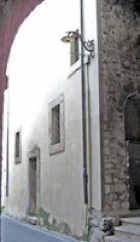
The complex passed to the Dominicans in 1616 and they retained its ownership after they moved their convent to what is now Piazza Garibaldi in 1626. They changed its dedication in honour of Pope Pius V, presumably after 1696, when the order instituted to process for his canonisation. (He was canonised in 1712).
Santa Reparata (1578)
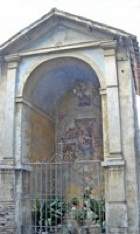
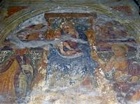
Santo Stefano (12th century)
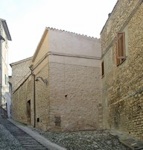
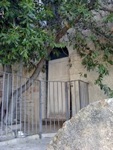
This hospice and adjacent church were first documented in 1177, when Pope Alexander III confirmed the complex as a possession of the Abbazia di San Pietro in Bovara.

The church was still in use in 1713, when it was recorded during the pastoral visit of Bishop Giacinto Lascaris of Spoleto. However, it was subsequently abandoned. The church is now a private house (illustrated to the right above).

